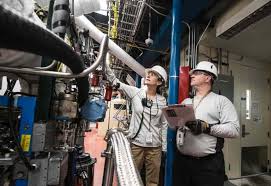Manual labor is common in blue-collar jobs. Those who work in these statistically lower-paying jobs are usually from the working class. Discover the history of this profession and examples of blue-collar worker jobs.
What Is a Blue Collar Worker?
Blue-collar workers are more typically employed in non-office settings (construction sites, production lines, driving, etc.). They carry out their responsibilities using their hands and physical abilities. Blue-collar workers include construction workers, machine operators, millwrights, assemblers, and truck drivers.
The concept of a blue-collar job does not specify the amount of skill or the sort of income workers receive: they can be skilled or unskilled, waged or salaried. It does imply that employees are more likely to work in jobs that will get their garments soiled, such as soil or grease. This is the origin of the term “blue collar,” which dates back to the early twentieth century, when these workers wore darker garments than “white collar” workers, or clothes more resistant to the increased wear and tear of physical labor, such as blue denim. However, workers in other service occupations, such as home health aides or cashiers, may also be classified as blue-collar.
Blue-collar workers are generally not exempt from overtime or minimum wage rules under federal law in the United States; however, some states may exempt specific sorts of blue-collar workers, such as drivers.
How Many Blue-Collar Workers Are There in the United States?
The Bureau of Labor Statistics (BLS) in the United States supplied the number of workers in each profession, including blue-collar jobs. In 2018, for example, construction laborers were roughly 1,405,000, while maintenance and repair workers totaled 1,488,000.
According to a 2018 Washington Post report, approximately 13.9 percent of workers are in blue-collar occupations.
Based on BLS data, the Center for Economic and Policy Research has created a map depicting the increase in blue-collar jobs. According to several studies, employers are currently having difficulty finding workers for blue-collar jobs.
Examples of Well-Paying Jobs For Blue-collar Worker
Here are some examples of blue-collar worker jobs with annual earnings over $50,000 in the United States.
#1. Diver National annual salary average: $53,535
Divers’ primary responsibilities include removing, installing, and repairing various underwater equipment and structures. To assist them, they employ dive equipment as well as hand and power instruments such as welding equipment or drills. Divers may conduct experiments or tests, or photograph buildings, in order to better inspect them.
#2. Repair manager National average annual salary: $54,549
Primary responsibilities: Repair managers hire and train staff, make facility repairs, and supervise their employees while they carry out their jobs. They order supplies as needed and ensure that all equipment is operational.
#3. Police officer: National average annual salary: $55,376
Primary responsibilities: Police officers enforce the law and make arrests for infractions. They patrol their assigned areas, answer police dispatch calls, identify potentially dangerous circumstances or conditions, and assist detectives with criminal investigations.
#4. Electrician: National average income for an electrician: $56,948 per year
Electricians build and repair electrical wiring and lighting systems, which are commonly found in homes, industries, and companies. They evaluate industrial equipment and electrical components such as circuit breakers to guarantee appropriate maintenance and safe operation.
#5. Criminal Investigator: National average salary for a criminal investigator: $57,995 per year
Primary responsibilities: Criminal investigators investigate crimes such as homicides, armed robberies, and sexual assaults. During their investigations, they gather evidence to aid in the resolution of a crime. Criminal investigators also collect notes and interview informants, witnesses, and possible subjects to gain a better knowledge of the crime.
#6. Aircraft mechanic: National average annual salary: $58,240
Aircraft mechanics’ primary responsibilities include inspecting and repairing aircraft engines. They ensure that all mechanical components perform properly and assist in identifying any damage, flaws, or dysfunction. Aircraft mechanics conduct their responsibilities using manual and power tools such as saws and grinders. They also make certain that all aircraft follow aviation rules and regulations.
#7. Plumber/pipefitter: National average annual salary: $59,087
Primary responsibilities: A plumber or pipefitter is someone who installs, fixes, and replaces pipes, faucets, and toilets. They test plumbing systems to ensure they are in good operating order. Plumbers and pipefitters use blueprints to find service panels and make necessary repairs.
#8. Derrick hand: Annual salary in the United States is $65,478.
Primary responsibilities: A derrick hand, often known as a derrickman, performs a variety of tasks depending on the rig they’re working on. They typically report to the oil driller and assist in guiding the drill pipe stands into the fingers at the top of an oil derrick.
#9. Production Manager: National average annual salary: $68,107
Primary responsibilities include planning production schedules, determining necessary resources, estimating production costs, negotiating with clients and managers, and overseeing the manufacturing process. They also verify that both health and safety laws are followed.
#10. Conductor: National average salary for conductor: $77,852 per year
Train or railroad conductors are responsible for the safe and orderly transfer of people and cargo. Other responsibilities of a conductor include checking passenger tickets, assisting passengers, and announcing the train’s arrival at a specific station.
#11. Boilermaker: National average salary: $80,027
Primary responsibilities: Boilermakers design and repair steam boilers as well as boiler house auxiliaries. They align boiler constructions or plat parts to form boiler frame tanks or vats using the required blueprints. Hand and power tools, turnbuckles, and levels are among the tools used by boilermakers on the job.
#12. Construction Manager: The national average annual Salary: $76,205
Construction managers are in charge of overseeing a construction project from start to finish. They plan deliverables, estimate project costs, and visit the construction site to assure timely completion. Construction managers also guarantee that all projects adhere to construction and safety laws.
Learn More About Becoming a Construction Manager
#13. General contractor: The national average annual salary: $117,713.
Primary responsibilities: General contractors offer the equipment, materials, and services required for a construction project. They frequently use subcontractors to complete some or all of the construction work on a project.
What Is the Difference Between a Blue-Collar and a White-Collar Worker?
The distinctions between a blue-collar and a white-collar worker have a lot to do with how they’re perceived. This covers how we perceive various industries, the level of education of individuals, their appearances, and social classes. However, keep in mind that none of this is necessarily founded on fact. It’s more about what people are led to believe about how each is defined.
Industries’ Perception
White-collar jobs are thought to be more desirable than blue-collar jobs. This is because society frequently considers office jobs to be superior to those that entail manual or strenuous labor. Simply put, due to the nature of the work, an office job is more desirable than one in the manufacturing or agricultural sectors.
If a country’s infrastructure is sophisticated enough to provide its workers with safe desk jobs that need cerebral concentration rather than physical activity, then the country is powerful enough to remove the weight of physical from the necessities of earning a living.
Education
There is an assumption that a blue-collar worker is less educated than a white-collar worker. This is due to the fact that an office job often necessitates a post-secondary education. A corporation seeking accountants, for example, often needs new workers to have an undergraduate degree in accounting or finance. Blue-collar workers may just need a few skills that can be learned on the job or at a trade school.
The historical basis for the two names may not have changed significantly since their inception. The term “blue-collar” comes from the prevalent appearance of a manual worker’s clothes. Blue jeans, overalls, and boilersuits are examples of such attire. Dark hues, such as blue, serve to conceal dirt and other materials that may soil work attire. White-collar is connected with business people wearing white button-down shirts with ties.
Social Groups
Another approach to explain these two terms is the belief that white-collar workers not only earn more money than blue-collar workers but also come from different social classes. White-collar workers are perceived to have higher status because they earn more and are more educated. Blue-collar workers, on the other hand, are thought to be lower on the social ladder due to manual labor and possibly a lack of education. Keep in mind that this isn’t always the case.
Is the Term “Blue-Collar” Derogatory?
It is possible. While there is nothing wrong with working in a blue-collar profession, the term “blue-collar” has historically been used to insult or offend people. This is because there is a widespread belief that blue-collar workers do not have the same earning capacity as white-collar workers and are less educated. Another common misconception is that blue-collar workers are at the bottom of the social ladder. While the distinctions between the two are blurred because of technology, the phrase still has some negative connotations.
Why Is Collar Color Used to Define Jobs?
The sort of collars, shirts, or apparel that workers frequently wore was used to classify jobs. Blue-collar workers, for example, were classed because they frequently wore blue (denim) shirts and apparel, which might conceal the oil, residue, and filth associated with certain occupations such as mechanic or factory worker. White-collar workers were so dubbed because they wore white shirts under their suits.
Are There Any Other Collar Colors Available?
Yes. However, many of these are not as common as blue-collar and white-collar jobs. White-collar workers with greater abilities and in higher demand are represented by the gold collar. Doctors, engineers, attorneys, and pilots are among them. Red-collar workers are government employees whose salaries are paid from the red ink budget. Farmers may also fall within this category. Pink-collar is an old word that was used to denote traditionally female-dominated industries such as nursing and secretarial work. The green collar is one of the newest sorts of collar colors, referring to jobs in the environmental sector.
Other Collars vs. Blue Collar
While blue and white collars are the most prevalent, other collar collars that signify distinct parts of the labor are less well-known. The other categories, unlike white and blue collars, are not formed from workers wearing any specific color of the shirt. Rather, their colors. They are as follows:
- Gold Collar: This category comprises legal and medical specialties. This could be a reference to the higher income these occupations command.
- Gray Collar: Individuals who are officially white-collar yet regularly perform blue-collar work as part of their jobs, such as engineers.
- Pink Collar: This group includes service workers such as nurses, secretaries, schoolteachers, salespeople, and wait staff. Pink-collar jobs were so named because they were traditionally held by women.
- Red collar refers to the red ink used to denote salaries in a budget. Workers in this sector are mostly civil servants who work at various levels of government.
- Green Collar: This category refers to those who work in the environmental field. Green collar jobs and persons work in conservation and sustainability-related fields.
Conclusion
Blue-collar workers are simply one of several types of workers. It has historically been used to characterize low-income individuals with little or no education and limited skills. Historically, blue-collar workers have worked in jobs that required manual labor. But, because of technological improvements, that has changed. Many blue-collar workers today have higher levels of education, and more skills, and earn as much (if not more) than their white-collar colleagues.
Related Articles
- FEDERAL LAWS THAT PROTECT EMPLOYEES: Why Your Boss Can’t Mistreat You
- HOW TO DEAL WITH DIFFICULT COWORKERS: Handling Difficult Staff Colleagues
- HOW DOES SALARY PAY WORK: How Salaried Workers are Compensated
- Men’s Clothing Business Casual: Best business casual for men (+tips)
- CONSTRUCTION BUSINESS: Detailed Startup Guide






